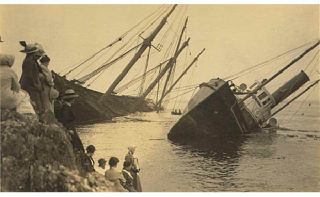Ray Burt, on left holding a snowball, and his brother Harry in front of a building at the family home near Davis Bay Rd. and Burt Rd. Their parents, John and Sarah (Baker) Burt brought the family from Iowa around 1905. John Burt was a professional photographer, and responsible for many of the fine images in our collection. He was also the “Watkins man” selling spices, soaps and liniments. Notice the two very tall snowmen on the right.
In heavy fog on Sunday, August 30, 1914, a San Juan Island legend began. Below the Hannah farm on the west side of San Juan Island, the America, a sailing ship turned barge, ran aground on the rocky shore.
The America was a three-masted full-rigged Down Easter built in Quincy, Massachusetts in 1874. The America hauled cargo from New York and Boston to the Far East until purchased by the James Griffiths Company in 1906. The ship was converted to a barge and plied the waters of Puget Sound until that fateful day in 1914. The ship was loaded with a shipment of coal and was being towed by the tug Lorne when it hit the rocks and eventually sank. The Lorne was later salvaged.
By August of 1914, The Great War had started in Europe and Britain had recently declared war on Germany. Local legend has it that the America’s cargo of coal was intended to be offloaded to a German vessel waiting in the Haro Strait. Despite U.S. ties to Britain, someone, somewhere had contracted to have a load of coal sold to Germany for their war effort.
In 1959 San Juan Island resident Roger Loring was the first person to dive on the wreck. He had heard stories of the wreck from his high school teacher, Ed Hannah, who was a young boy when he heard the ships hitting the rocks below his family farm years before. Many artifacts were salvaged most notable being the rudder and figurehead. The rudder is on display at the San Juan Historical Museum and the Columbia figurehead displayed at Rosario Resort.
Recently, the Hannah family has donated several items from the America to the San Juan Historical Museum, including parts of the rigging and posts from the deck railing. The true story of the cargo’s destination may never be known, but the legend of the America is forever ingrained in the historical fabric of San Juan Island.



